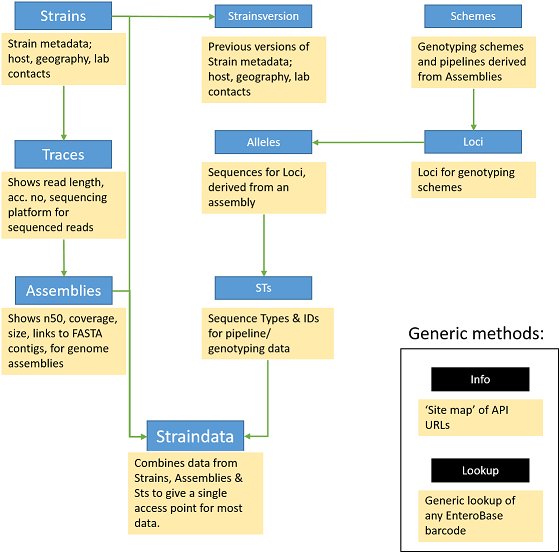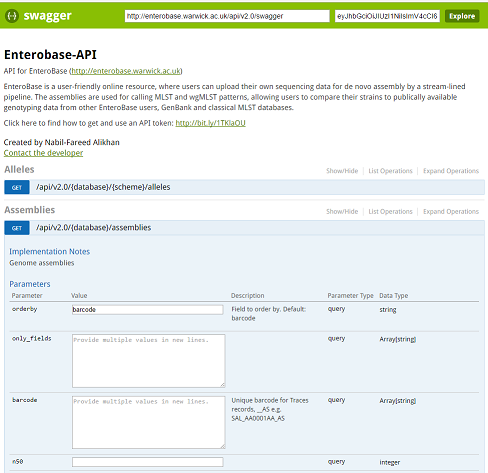Wiki
Clone wikienterobase-web / api_structure
Top level links:
- Main top level page for all documentation
- EnteroBase Features
- Registering on EnteroBase and logging in
- Tutorials
- Using the API
- About the underlying pipelines and other internals
- How schemes in EnteroBase work
- FAQ
Understanding the EnteroBase API Structure
The API tends to follow the logical structure for MLST and NGS data in general. e.g. Strains > Traces > Assemblies, and Loci > Alleles > Sequence types (STs).
There are generic query methods such as Lookup and Info that will help with straightforward lookups of information. If you have any suggestions for new endpoints to help your work, please let us know.

The Swagger sandbox
Swagger is an API framework used in the EnteroBase API. It provides interactive documentation of the EnteroBase API, including information about endpoints, inputs, outputs and response codes.
Link to Enterobase's interactive API documentation (swagger-ui): http://enterobase.warwick.ac.uk/api/v2.0/swagger-ui

You can just right into playing with requests. There is a demo token already embedded, which is only valid for the Salmonella database ('senterica').
Understanding Barcodes
Almost all data in EnteroBase is assigned a unique Barcode. This is a unique identifier across all of EnteroBase. It follows a very straightforward structure, split by underscores:
#!html SAL_AA0019AA_ST
- The first part (e.g. SAL) defines the database
- The middle encodes an ID number, letters are used to allow more information per character similar to a UK postcode (CV4 7AL).
- The last part defines the datatype (e.g. ST is Sequence Type record).
Databases are encoded:
| Genus | Tag |
|---|---|
| Salmonella | SAL |
| Escherichia | ESC |
| Yersinia | YER |
| Moraxella | MOR |
Datatypes are encoded:
| Datatype | Barcode tag |
|---|---|
| Schemes | SC |
| Loci | LO |
| Alleles | AL |
| Assemblies | AS |
| STs | ST |
| Traces | TR |
| Strains | None or SS |
Rapid Barcode lookup
Some barcodes can be quickly looked up using the Lookup endpoint in the API. A request is as simple as :
#!html http://enterobase.warwick.ac.uk/api/v2.0/lookup?barcode=SAL_AA0019AA_ST
This gives you a full information on the record, which in this case is about Sequence Type 19 (Salmonella Typhimurium).
#!json { "records": 1, "results": [ { "ST_id": 19, "accepted": 1, "alleles": [ { "accepted": 1, "allele_id": 10, "allele_name": null, "locus": "aroC" }, { "accepted": 1, "allele_id": 7, "allele_name": null, "locus": "dnaN" }, { "accepted": 1, "allele_id": 12, "allele_name": null, "locus": "hemD" }, { "accepted": 1, "allele_id": 9, "allele_name": null, "locus": "hisD" }, { "accepted": 1, "allele_id": 5, "allele_name": null, "locus": "purE" }, { "accepted": 1, "allele_id": 9, "allele_name": null, "locus": "sucA" }, { "accepted": 1, "allele_id": 2, "allele_name": null, "locus": "thrA" } ], "barcode": "SAL_AA0019AA_ST", "create_time": "2015-11-24 19:59:36.295460", "index_id": 19, "info": { "lineage": "", "predict": { "serotype": [ [ "Typhimurium", 7372 ], [ "Typhimurium Var. 5-", 440 ], [ "Typhimurium Var. O:5-", 208 ] }, "st_complex": "1", "subspecies": "" }, "lastmodified": "2017-02-19 01:44:21.503891", "lastmodified_by": "admin", "reference": { "lab_contact": "DVI", "refstrain": "9924828", "source": "mlst.warwick.ac.uk" }, "scheme": "UoW", "scheme_index": 1, "version": 4885 } ] }
You can play around with this feature in the interactive documentation

Navigating the API
There is a top-level API page which can be used to find the direct links to the various endpoints for a given database. The interactive documentation is derived from the API itself and is always up-to-date.
You can use either resource if you are lost.
#!html http://enterobase.warwick.ac.uk/api/v2.0
#!json [ { "description": "Salmonella", "links": { "assemblies": "http://enterobase.warwick.ac.uk/api/v2.0/senterica/assemblies", "current": "http://enterobase.warwick.ac.uk/api/v2.0", "schemes": "http://enterobase.warwick.ac.uk/api/v2.0/senterica/schemes", "straindata": "http://enterobase.warwick.ac.uk/api/v2.0/senterica/straindata", "strains": "http://enterobase.warwick.ac.uk/api/v2.0/senterica/strains", "sts": "http://enterobase.warwick.ac.uk/api/v2.0/senterica/rMLST/sts", "traces": "http://enterobase.warwick.ac.uk/api/v2.0/senterica/traces" }, "name": "senterica", "prefix": "SAL", "tables": "{'schemes': 'SC', 'snps': 'SN', 'alleles': 'AL', 'assemblies': 'AS', 'loci': 'LO', 'taxondef': 'TA', 'strains': 'SS', 'datadefs': 'DE', 'sts': 'ST', 'traces': 'TR', 'archive': 'AR', 'refsets': 'RE'}" } ]
Updated